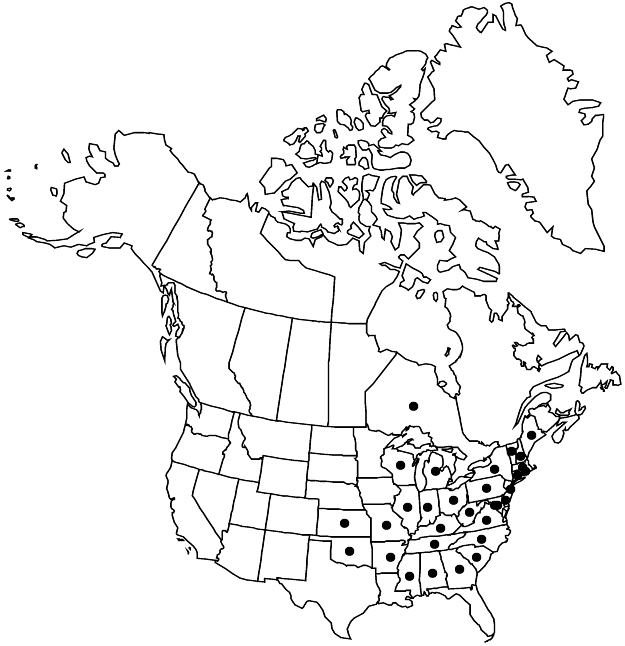Difference between revisions of "Vaccinium pallidum"
Hort. Kew. 2: 10. 1789 ,.
FNA>Volume Importer |
imported>Volume Importer |
||
| (6 intermediate revisions by 2 users not shown) | |||
| Line 7: | Line 7: | ||
}} | }} | ||
|common_names=Blue Ridge or late low-bush blueberry | |common_names=Blue Ridge or late low-bush blueberry | ||
| + | |special_status={{Treatment/ID/Special_status | ||
| + | |code=E | ||
| + | |label=Endemic | ||
| + | }} | ||
|basionyms= | |basionyms= | ||
|synonyms={{Treatment/ID/Synonym | |synonyms={{Treatment/ID/Synonym | ||
|name=Cyanococcus liparis | |name=Cyanococcus liparis | ||
|authority=Small | |authority=Small | ||
| − | }}{{Treatment/ID/Synonym | + | |rank=species |
| + | }} {{Treatment/ID/Synonym | ||
|name=Cyanococcus margarettae | |name=Cyanococcus margarettae | ||
|authority=(Ashe) Small | |authority=(Ashe) Small | ||
| − | }}{{Treatment/ID/Synonym | + | |rank=species |
| + | }} {{Treatment/ID/Synonym | ||
|name=Cyanococcus pallidus | |name=Cyanococcus pallidus | ||
|authority=(Aiton) Small | |authority=(Aiton) Small | ||
| − | }}{{Treatment/ID/Synonym | + | |rank=species |
| + | }} {{Treatment/ID/Synonym | ||
|name=Cyanococcus subcordatus | |name=Cyanococcus subcordatus | ||
|authority=Small | |authority=Small | ||
| − | }}{{Treatment/ID/Synonym | + | |rank=species |
| + | }} {{Treatment/ID/Synonym | ||
|name=Cyanococcus tallapusae | |name=Cyanococcus tallapusae | ||
|authority=Coville ex Small | |authority=Coville ex Small | ||
| − | }}{{Treatment/ID/Synonym | + | |rank=species |
| + | }} {{Treatment/ID/Synonym | ||
|name=Cyanococcus vacillans | |name=Cyanococcus vacillans | ||
|authority=(Kalm ex Torrey) Rydberg | |authority=(Kalm ex Torrey) Rydberg | ||
| − | }}{{Treatment/ID/Synonym | + | |rank=species |
| + | }} {{Treatment/ID/Synonym | ||
|name=Vaccinium altomontanum | |name=Vaccinium altomontanum | ||
|authority=Ashe | |authority=Ashe | ||
| − | }}{{Treatment/ID/Synonym | + | |rank=species |
| + | }} {{Treatment/ID/Synonym | ||
|name=Vaccinium corymbosum var. pallidum | |name=Vaccinium corymbosum var. pallidum | ||
|authority=(Aiton) A. Gray | |authority=(Aiton) A. Gray | ||
| − | }}{{Treatment/ID/Synonym | + | |rank=variety |
| + | }} {{Treatment/ID/Synonym | ||
|name=Vaccinium margarettae | |name=Vaccinium margarettae | ||
|authority=Ashe | |authority=Ashe | ||
| − | }}{{Treatment/ID/Synonym | + | |rank=species |
| + | }} {{Treatment/ID/Synonym | ||
|name=Vaccinium vacillans | |name=Vaccinium vacillans | ||
|authority=Kalm ex Torrey | |authority=Kalm ex Torrey | ||
| − | }}{{Treatment/ID/Synonym | + | |rank=species |
| + | }} {{Treatment/ID/Synonym | ||
|name=Vaccinium vacillans var. crinitum | |name=Vaccinium vacillans var. crinitum | ||
|authority=Fernald | |authority=Fernald | ||
| − | }}{{Treatment/ID/Synonym | + | |rank=variety |
| + | }} {{Treatment/ID/Synonym | ||
|name=Vaccinium vacillans var. missouriense | |name=Vaccinium vacillans var. missouriense | ||
|authority=Ashe | |authority=Ashe | ||
| − | }}{{Treatment/ID/Synonym | + | |rank=variety |
| + | }} {{Treatment/ID/Synonym | ||
|name=Vaccinium viride | |name=Vaccinium viride | ||
| − | |authority= | + | |authority= |
| + | |rank=species | ||
}} | }} | ||
|hierarchy=Ericaceae;Ericaceae subfam. Vaccinioideae;Vaccinium;Vaccinium sect. Cyanococcus;Vaccinium pallidum | |hierarchy=Ericaceae;Ericaceae subfam. Vaccinioideae;Vaccinium;Vaccinium sect. Cyanococcus;Vaccinium pallidum | ||
| Line 62: | Line 79: | ||
|elevation=0-1600 m | |elevation=0-1600 m | ||
|distribution=Ont.;Ala.;Ark.;Conn.;Del.;D.C.;Ga.;Ill.;Ind.;Kans.;Ky.;Maine;Md.;Mass.;Mich.;Miss.;Mo.;N.H.;N.J.;N.Y.;N.C.;Ohio;Okla.;Pa.;R.I.;S.C.;Tenn.;Vt.;Va.;W.Va.;Wis. | |distribution=Ont.;Ala.;Ark.;Conn.;Del.;D.C.;Ga.;Ill.;Ind.;Kans.;Ky.;Maine;Md.;Mass.;Mich.;Miss.;Mo.;N.H.;N.J.;N.Y.;N.C.;Ohio;Okla.;Pa.;R.I.;S.C.;Tenn.;Vt.;Va.;W.Va.;Wis. | ||
| − | |discussion=<p>The flowers of Vaccinium pallidum are visited primarily by Andrena carlini Cockerell and Bombus spp. This species occasionally hybridizes with V. angustifolium, yielding V. ×dobbinii Burnham.</p> | + | |discussion=<p>The flowers of <i>Vaccinium pallidum</i> are visited primarily by Andrena carlini Cockerell and Bombus spp. This species occasionally hybridizes with <i>V. angustifolium</i>, yielding V. ×dobbinii Burnham.</p> |
|tables= | |tables= | ||
|references={{Treatment/Reference | |references={{Treatment/Reference | ||
| Line 74: | Line 91: | ||
-->{{#Taxon: | -->{{#Taxon: | ||
name=Vaccinium pallidum | name=Vaccinium pallidum | ||
| − | |||
|authority=Aiton | |authority=Aiton | ||
|rank=species | |rank=species | ||
| Line 88: | Line 104: | ||
|publication title=Hort. Kew. | |publication title=Hort. Kew. | ||
|publication year= | |publication year= | ||
| − | |special status= | + | |special status=Endemic |
| − | |source xml=https:// | + | |source xml=https://bitbucket.org/aafc-mbb/fna-data-curation/src/2e0870ddd59836b60bcf96646a41e87ea5a5943a/coarse_grained_fna_xml/V8/V8_1032.xml |
|subfamily=Ericaceae subfam. Vaccinioideae | |subfamily=Ericaceae subfam. Vaccinioideae | ||
|genus=Vaccinium | |genus=Vaccinium | ||
Latest revision as of 22:41, 5 November 2020
Shrubs, erect, (3–)4–12(–40) dm, rhizomatous, (twigs of previous year not verrucose). Leaves persistent. Inflorescences terminal, racemes, on lateral twigs, on previous year’s shoots or older woody stems. Pedicels articulated with calyx tube. Flowers: sepals 5; petals 4–5, connate for nearly their entire lengths, corolla cylindric or urceolate; stamens 10, included; anthers ± without awns, tubules 1–1.5 mm, with terminal pores. Berries [4-], 5-, [pseudo 8-, or pseudo 10]-locular. Seeds 10–25, (ca. 1 mm).
Phenology: Flowering mid-late spring.
Habitat: Dry, open oak or oak- hickory woods, open pine woods, ledges, abandoned farmland or cut-over deciduous forests
Elevation: 0-1600 m
Distribution

Ont., Ala., Ark., Conn., Del., D.C., Ga., Ill., Ind., Kans., Ky., Maine, Md., Mass., Mich., Miss., Mo., N.H., N.J., N.Y., N.C., Ohio, Okla., Pa., R.I., S.C., Tenn., Vt., Va., W.Va., Wis.
Discussion
The flowers of Vaccinium pallidum are visited primarily by Andrena carlini Cockerell and Bombus spp. This species occasionally hybridizes with V. angustifolium, yielding V. ×dobbinii Burnham.